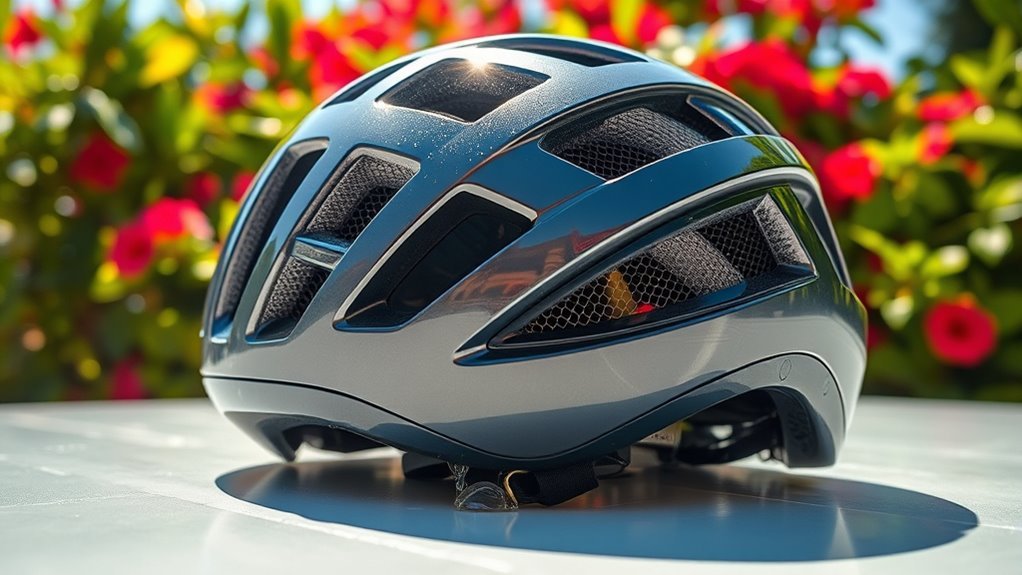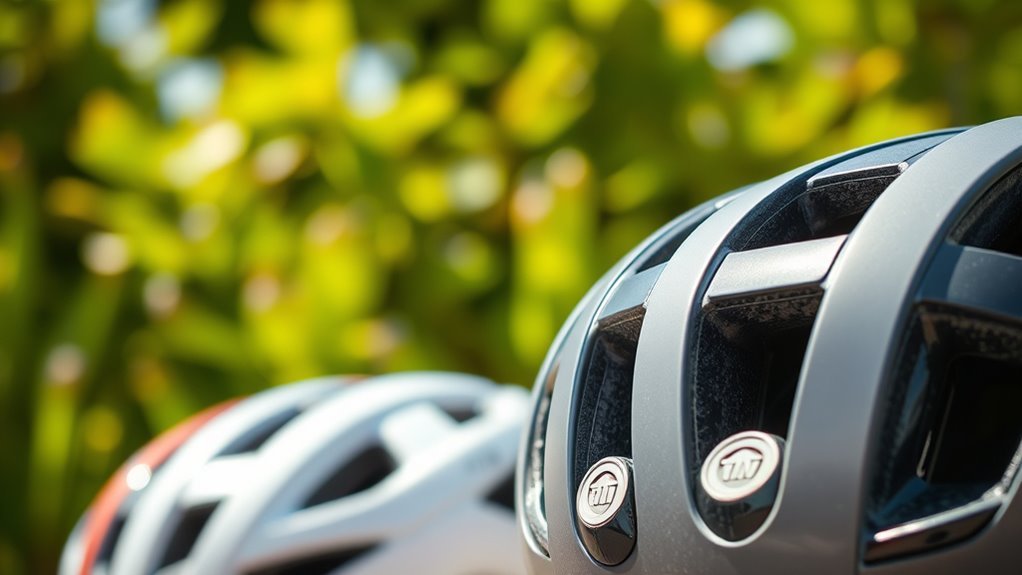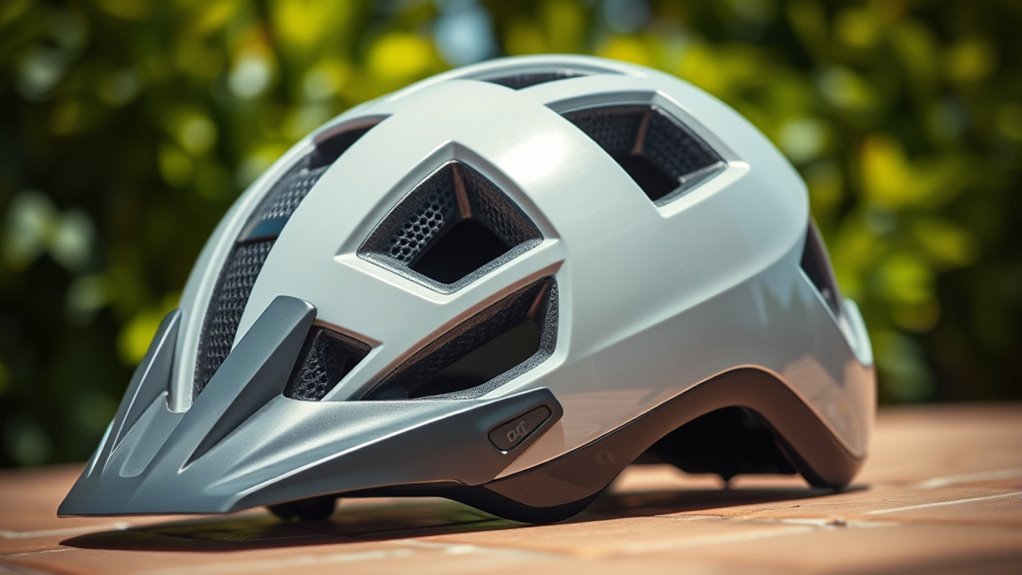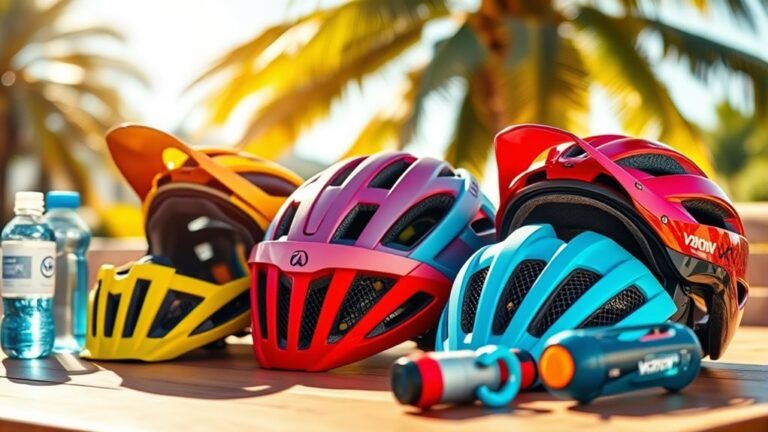Best Helmets for Hot Weather: Ventilation Guide
When choosing a helmet for hot weather, focus on ventilation to guarantee comfort and safety. Look for features like adjustable air vents, moisture-wicking liners, and lightweight materials that enhance airflow. A well-ventilated helmet allows hot air to escape while bringing in cooler air, reducing heat buildup. Don’t forget about durability and reflective elements for visibility. Understanding these features can help you make an informed choice—there’s much more to explore for finding the perfect helmet.
Importance of Ventilation in Helmets

When you’re riding in hot weather, the importance of ventilation in helmets can’t be overstated. Many riders fall victim to ventilation myths, believing that all helmets provide adequate airflow. In reality, the effectiveness of cooling technologies varies widely. A well-ventilated helmet allows hot air to escape while drawing in cooler air, maintaining comfort and concentration during your ride. Look for designs featuring strategically placed vents that channel airflow efficiently, preventing heat buildup that can lead to fatigue. Additionally, some helmets incorporate moisture-wicking liners that work in tandem with ventilation systems, enhancing the cooling effect. Prioritizing ventilation not only enhances comfort but also guarantees your focus remains on the freedom of the open road, making every ride a pleasure rather than a struggle against the heat.
Features to Look for in Hot Weather Helmets

Choosing the right helmet for hot weather involves more than just picking a lightweight model; it is essential to look for specific features that enhance comfort and safety. Focus on ventilation systems that promote airflow, as well as moisture-wicking liners for effective temperature regulation. Adjustable straps and padding can help you achieve a snug fit without compromising comfort. Consider helmets with reflective materials for added visibility during your rides.
| Feature | Importance | Benefits |
|---|---|---|
| Ventilation | Enhances airflow | Keeps you cool |
| Moisture-wicking | Regulates sweat | Reduces discomfort |
| Adjustable straps | Guarantees proper fit | Maximizes helmet safety |
| Light materials | Reduces weight | Increases comfort |
| Reflective elements | Improves visibility | Enhances safety |
Top Cycling Helmets for Hot Weather

When choosing a cycling helmet for hot weather, you’ll want to focus on options that utilize lightweight materials and a streamlined design to minimize heat retention. Effective ventilation systems are equally essential, as they allow for maximum airflow to keep you cool during long rides. Let’s explore some top models that excel in these areas, ensuring you stay comfortable and protected.
Lightweight Materials and Design
In the sweltering heat of summer, a cycling helmet’s weight and design can make all the difference in your comfort and performance. Opting for helmets with lightweight construction is essential; they minimize strain on your neck during long rides. Look for models made with advanced materials like polycarbonate or in-mold technology, which maintain safety without the bulk. Additionally, helmets featuring breathable fabrics enhance airflow, keeping your head cool. These materials wick moisture away, preventing sweat buildup that can distract you. When choosing a helmet, consider how the design promotes a snug fit without compromising ventilation, ensuring you enjoy your ride without feeling weighed down. Your freedom to explore the open road depends on these thoughtful choices in helmet design.
Effective Ventilation Systems
Effective ventilation systems are essential for staying cool and comfortable during those hot summer rides. You’ll want a helmet that incorporates advanced ventilation technology, featuring strategically placed vents to maximize airflow. Look for designs with large front vents that channel fresh air in while allowing hot air to escape through rear exhaust ports. Some helmets utilize innovative cooling mechanisms, such as moisture-wicking liners that draw sweat away from your head, enhancing comfort and cooling. Additionally, consider models with adjustable vents, so you can customize airflow depending on your ride intensity. A well-ventilated helmet not only keeps you cooler but also improves your focus, allowing you to enjoy the freedom of the road without distraction. Choose wisely, and ride freely!
Best Motorcycle Helmets for Heat
When riding in hot weather, the right motorcycle helmet can make all the difference in your comfort and safety. You’ll want to focus on essential ventilation features that promote airflow, lightweight materials that reduce neck strain, and aerodynamic designs that help minimize drag. Each of these elements plays a vital role in keeping you cool and focused on the road ahead.
Essential Ventilation Features
Choosing a motorcycle helmet that keeps you cool during hot weather is crucial, especially if you spend long hours on the road. Essential ventilation features, like advanced ventilation technology, can greatly enhance your riding experience. Look for helmets that prioritize airflow optimization, ensuring a steady stream of fresh air passes through.
| Feature | Importance | Example Helmet |
|---|---|---|
| Air Vents | Maximizes airflow | Brand X Model A |
| Moisture-Wicking Liner | Reduces sweat build-up | Brand Y Model B |
| Adjustable Vents | Customizable airflow | Brand Z Model C |
Investing in a helmet with these features means embracing freedom, comfort, and safety. Stay cool, and enjoy the ride!
Lightweight Materials Importance
While it might be tempting to prioritize style over substance, opting for lightweight materials in a motorcycle helmet is vital for maintaining comfort during hot weather. You want to feel free on the open road, and lightweight designs allow for that exhilarating experience. Consider these aspects:
- Reduced fatigue: Lighter helmets mean less strain on your neck during long rides.
- Enhanced airflow: Lightweight materials often come with better ventilation options, keeping you cool.
- Improved agility: A lighter helmet allows for quick head movements, essential for safety.
- Material durability: Advanced lightweight materials are often engineered for strength, guaranteeing protection without the bulk.
Choosing a helmet that balances these qualities guarantees your ride remains liberating and comfortable, even in the heat.
Aerodynamic Design Benefits
Although you might not initially think about aerodynamics when selecting a helmet, its design plays a crucial role in your comfort and safety during hot weather rides. Helmets with ideal aerodynamic efficiency reduce drag, allowing you to slice through the wind effortlessly. This design not only enhances your riding experience but also contributes to better airflow dynamics, promoting effective ventilation. When air flows smoothly over your helmet, it helps to regulate temperature, keeping you cooler on those scorching days. Additionally, a well-designed, aerodynamic helmet minimizes turbulence, reducing fatigue and distraction. So when you’re choosing a helmet, consider how its aerodynamic features can enhance your freedom on the road, ensuring you stay comfortable and focused during your adventures.
Helmets for Other Outdoor Activities
How do you guarantee safety and comfort during outdoor activities in sweltering heat? Choosing the right helmets, like kayaking helmets and climbing helmets, is essential. These helmets not only protect you but also enhance your enjoyment under the sun. Here are some features to take into account:
Choosing the right helmets ensures safety and comfort during outdoor activities in sweltering heat, enhancing your enjoyment under the sun.
- Ventilation: Ensure airflow to keep you cool.
- Lightweight Design: A lighter helmet reduces fatigue during long sessions.
- Moisture-Wicking Padding: This helps manage sweat and keeps you comfortable.
- Adjustable Fit: A snug yet comfortable fit prevents movement and distractions.
Material Considerations for Breathability
When selecting helmets for hot weather activities, the materials used can greatly impact breathability and overall comfort. Look for helmets made with breathable fabrics that allow air to circulate, reducing heat buildup during your adventures. Lightweight materials like polycarbonate and EPS foam not only provide protection but also enhance airflow. Additionally, helmets featuring advanced cooling technologies, such as moisture-wicking liners, can further improve comfort by drawing sweat away from your skin. This combination of breathable materials and innovative designs guarantees that you stay cool even in sweltering conditions. Ultimately, choosing the right materials can make a significant difference, allowing you to focus on the freedom of your pursuits without the distraction of heat discomfort.
Maintenance Tips for Keeping Helmets Cool
While you might think that once you’ve chosen a breathable helmet, your work is done, regular maintenance is essential to guarantee it stays cool and effective over time. Here are some maintenance tips to keep your helmet in top shape:
- Regular helmet cleaning: Remove dirt and sweat buildup to improve airflow.
- Check padding: Replace or wash the padding regularly to make certain of comfort and ventilation.
- Inspect vents: Make sure vents aren’t blocked; clean them periodically to enhance cooling.
- Utilize cooling accessories: Consider adding cooling pads or moisture-wicking liners for extra comfort.
User Reviews and Recommendations
User feedback plays a significant role in selecting the right helmet for hot weather. When browsing user reviews, you’ll notice consistent themes—ventilation and comfort top the list. Riders often recommend helmets with ample airflow, highlighting models like the XYZ Airflow for its exceptional cooling features. Many users appreciate lightweight designs that don’t compromise safety, sharing how these helmets enhance their riding experience during sweltering days. Additionally, user recommendations frequently mention moisture-wicking liners, which help keep sweat at bay. When evaluating options, pay attention to real-life experiences; they can guide you toward the perfect helmet that meets your needs. Ultimately, user insights can empower you to make an informed choice, ensuring you stay comfortable and safe while enjoying the freedom of the ride.
Frequently Asked Questions
How Do I Measure My Head for the Right Helmet Size?
To measure your head for the right helmet size, you’ll need a soft measuring tape. Wrap it around the widest part of your head, just above your ears. Note the circumference in inches or centimeters. Then, consult a sizing guide specific to the helmet brand you’re considering, as sizes can vary. Remember, a proper helmet fitting should feel snug but not uncomfortable—ensuring your freedom and safety while riding.
Can I Wear a Beanie Under My Helmet for Added Warmth?
Absolutely, you can wear a beanie under your helmet for that extra layer of warmth. Just make certain you choose the right beanie types—think lightweight, moisture-wicking options that won’t compromise your fit. While you’re basking in the cozy embrace, be mindful of warmth retention; too thick a beanie might cramp your style or impede airflow. Enjoy that snug feeling, but guarantee your helmet remains comfortable and securely positioned for safety.
Are There Any Specific Brands Known for Excellent Ventilation?
Absolutely, several brands excel in ventilation technology. Look at Giro and Bell; their helmets often feature advanced airflow systems that keep you cool. Specialized is another brand known for its focus on breathability, using innovative materials to enhance comfort. When making brand comparisons, consider models with adjustable vents, as they allow you to customize airflow based on conditions. Ultimately, a well-ventilated helmet can make a significant difference in your riding experience.
How Often Should I Replace My Helmet for Safety?
Regularly replacing your helmet’s essential for maintaining safety standards. Generally, you should consider a helmet’s lifespan to be around three to five years, even if it hasn’t sustained any visible damage. Over time, materials can degrade, compromising protection. If you’ve had a crash or dropped your helmet, replace it immediately, regardless of age. Prioritizing personal safety guarantees you enjoy your rides freely, knowing you’re protected by a reliable, robust helmet.
Can I Customize My Helmet’s Ventilation System?
Yes, you can customize your helmet’s ventilation system! Many helmets come with ventilation modifications, allowing you to adjust airflow based on your needs. You might consider adding helmet accessories like removable vents or adjustable airflow panels for enhanced comfort. It’s important to verify these modifications don’t compromise safety. Always check compatibility with your helmet model and follow manufacturer guidelines to maintain protection while enjoying that personalized touch and ideal ventilation.






